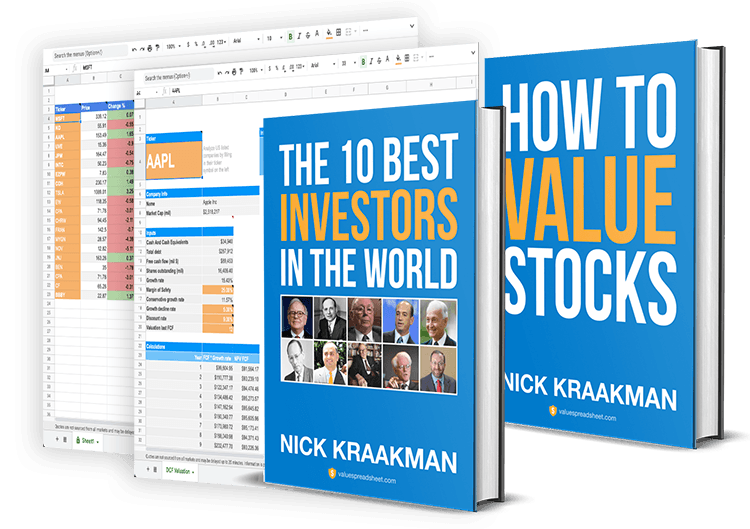Transcript
Hello guys, welcome to episode 19 of the Value Investing Bootcamp podcast.
I'm your host, Nick Kraakman, and in the previous episodes we have been talking about when to buy and when to sell.
This is an aspect of portfolio management, and portfolio management is something which we will cover in more depth in this particular episode.
But you know, I've been talking for 19, or 18 episodes now, this is episode 19.
I can talk about this stuff for probably another, I don't know, 100 episodes, but the fact of the matter is that this is just improvisation.
I try to cover.. I try to give you a general idea about the value investing philosophy, but if you want to have a complete, structured overview of all the ins and outs of value investing, to get a complete package from A to Z, including spreadsheets, checklists, videos, the whole thing, I suggest you check out my Value Investing Bootcamp video course, which is available on Udemy, which is a great, great platform to learn, as well as on my own website.
There are courses about literally every single subject on Udemy.
However, when I came to that website, I found that there wasn't that much about investing yet.
That's why I decided to create a comprehensive course about value investing.
If you're interested, just have a look, go to ValueInvestingBootcamp.com.
For now, let's focus on portfolio management a bit more.
Like I said, we covered when to buy and when to sell.
Another aspect of portfolio management is how many stocks should you own?
I mean, you have a portfolio of stocks, and then they always preach to diversify, to spread the risk of your portfolio, because if you have only one stock and that stock goes bankrupt, then your entire investment, all the money you have invested, goes down the drain.
However, if you have several stocks, you spread the risk.
So, if one stock doesn't perform as well, but another one performs more than you, or better than you expected, then you know, it averages out.
But this is also at the same time sort of a problem, the averaging out, because if you diversify enough, then what you're left with is mediocre returns, because you will simply mimic the returns of the stock market, and what we want, what we are aiming for at least, are above average returns, consistently, and the only way to achieve this is minimized diversification.
Because we've talked about risk before in one of the earlier episodes, and Warren Buffett said, “Risk comes from not knowing what you're doing.”
If you know what you're doing, if you have a solid strategy, and you apply it consistently, then there's not a huge reason why you should diversify.
If you are absolutely certain about your analysis, and you are sure that you have a couple of great companies in your basket, then you don't need more.
Because we've mentioned before that there are only, I mean, it's very hard to find true bargains, truly great companies that are selling for bargain prices.
So, if you own a couple, you've already been quite lucky to find them.
It's just impossible to find 30 companies that are actually great selling at bargain prices, so what I suggest is to stick to 10 companies or less, because another benefit is that this allows you to become an expert on all of them, because you have the time to follow the news on all of them, read their financial statements, just stay up to date stay on top of them.
So, you will always know what is going on with all the companies in your portfolio.
This is simply impossible if you own 30 companies or more.
It makes no sense, you can't stay on top of all of them, and your 30th best idea just won't be as good as your best idea.
Another aspect of portfolio management is the fact that you have to re-evaluate your holdings continuously.
Re-evaluating them means that once in a while you check up on them, see how they're performing, if your initial reason for buying them is still valid.
If not, you might have to consider selling them and purchasing a better opportunity.
So, re-evaluating your holdings from time to time is another crucial aspect of portfolio management.
And finally, I would like to point out that you should try to minimize the amount of trades that you make.
So, you look for great opportunities, and when you find them, you invest big, so you put a lot of money in it.
However, keep in mind, though I haven't even covered this yet, but this is important, to not buy a full position in one go.
What I mean by that is that you can average down as it's called.
So, let's say you purchase a stock at $10, and then it drops to $8.
If you thought the company was a good buy a $10, it's a great buy at $8, so you buy some more at eight.
However, then your average price will be the average of $10 and $8, which is $9.
So, your purchase price, your average purchase price will go down.
This would be impossible if you would have put all your money into the stock when it was trading at 10.
So, always purchase in steps, that's what I suggest, so you can buy more when the price goes down further.
And minimizing trades is also about avoiding taxes, or at least minimizing taxes, because avoiding taxes will get you in big trouble.
If you want to minimize taxes, for example, let's look at the taxation system in the US.
It's actually beneficial for long term traders, or investors, and not so beneficial for short term traders.
Short term traders have to pay more tax out of their income, which they get out of their investments.
Short term is considered one year or less, so if you hold on to stocks for more than one year, you're already paying less taxes.
But then again, if you hold on to them for several years, what also happens is that you have to pay taxes less frequently, and we've talked about compounding interest and the power of that.
What happens is that you don't pay your taxes over your investments until you actually sell, so if you don't sell, yeah, that money, that tax money that you actually would have to pay, remains invested.
So, you keep earning money over that tax money that you actually owe!
This way, you can grow your money quicker than when you would sell it every year, pay some taxes, and then reinvest, because then you would have less money left to earn an interest over.
So, that's an interesting thing.
So, buy and hold actually really pays off in several ways.
First, because you pay taxes less frequently.
Secondly, you pay less taxes, because you have the long term tax rate and not the short term tax rate.
And finally, and most importantly, is because you earn compounded interest over that tax money that you aren't paying until you actually sell the stock.
So, don't diversify too much, re-evaluate your holdings from time to time, and yeah, a long term strategy is preferred, so don't trade too frequently.
Personally, I trade around once or twice every quarter.
That was it for today.
Next episode will be the final episode of this limited edition podcast series.
I hope you enjoyed it so far, and in the final episode we'll talk about how a financial crisis like the one we just witnessed emerges, and how you can profit from hype and pessimism.
So, I'll see you in the final episode.
Thanks a lot, guys!
If you enjoyed today's show, head over to ValueInvestingBootcamp.com to find out more on how you can invest like the pros, manage your own portfolio with confidence, and consistently earn mind boggling returns on the stock market.



